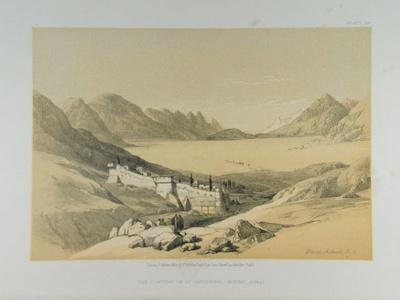| Method | Lithograph with tint stone |
| Artist | after David Roberts |
| Published | London, Published March. 1st 1856, by Day & Son, Gate Street, Lincoln's Inn Fields |
| Dimensions | Image 146 x 212 mm, Sheet 205 x 285 mm |
| Notes |
Plate 116 from Volume 3 of the small format reprint of Roberts' The Holy Land, Syria, Idumea, Arabia, Egypt & Nubia. A view of the Monastery of St Catherine in the Sinai, Egypt. The Greek Orthodox monastery was built during the 6th century AD to house the remains of Catherine of Alexandria, a Christian martyr usually identified with the instrument of her torture, the 'Catherine' wheel. The monastery is one of the very oldest in the Christian tradition, and contains the world's oldest continuously working libraries, containing a collection of manuscripts and codices second only to the Vatican, as well as the largest and best collection of early Christian icons in the world. As a result, the monastery has a very long history of pilgrimage. In Roberts' view, the monastery is depicted from the East, looking down into the valley, with the foot of Mount Sinai to the left of the massive walls of the Monastery. In the foreground, a group of Bedouins gather behind some large rocks on an outcrop overlooking the valley. In the far distance, a camel train snakes its way along the valley floor. David Roberts RA (24th October 1796 – 25th November 1864) was a Scottish painter. He is especially known for a prolific series of detailed prints of Egypt and the Near East produced during the 1840s from sketches made during long tours of the region (1838-1840). This work, and his large oil paintings of similar subjects, made him a prominent Orientalist painter. He was elected as a Royal Academician in 1841. The firm of Day & Haghe was one of the most prominent lithographic companies of the nineteenth-century. They were also amongst the foremost pioneers in the evolution of chromolithography. The firm was established in 1823 by William Day, but did not trade under the moniker of Day & Haghe until the arrival of Louis Haghe in 1831. In 1838, Day & Haghe were appointed as Lithographers to the Queen. However, and perhaps owing to the fact that there was never a formal partnership between the two, Haghe left the firm in the 1850's to devote himself to watercolour painting. The firm continued as Day & Son under the guidance of William Day the younger (1823 - 1906) but, as a result of a scandal involving Lajos Kossuth, was forced into liquidation in 1867. Vincent Brookes bought the company in the same year, and would produce the caricatures for Gibson Bowles' Vanity Fair magazine, as well as the illustrations for Cassells's Poultry Book, amongst other commissions. Condition: Light foxing to margins, not affecting image. |
| Framing | unmounted |
| Price | £30.00 |
| Stock ID | 39018 |

